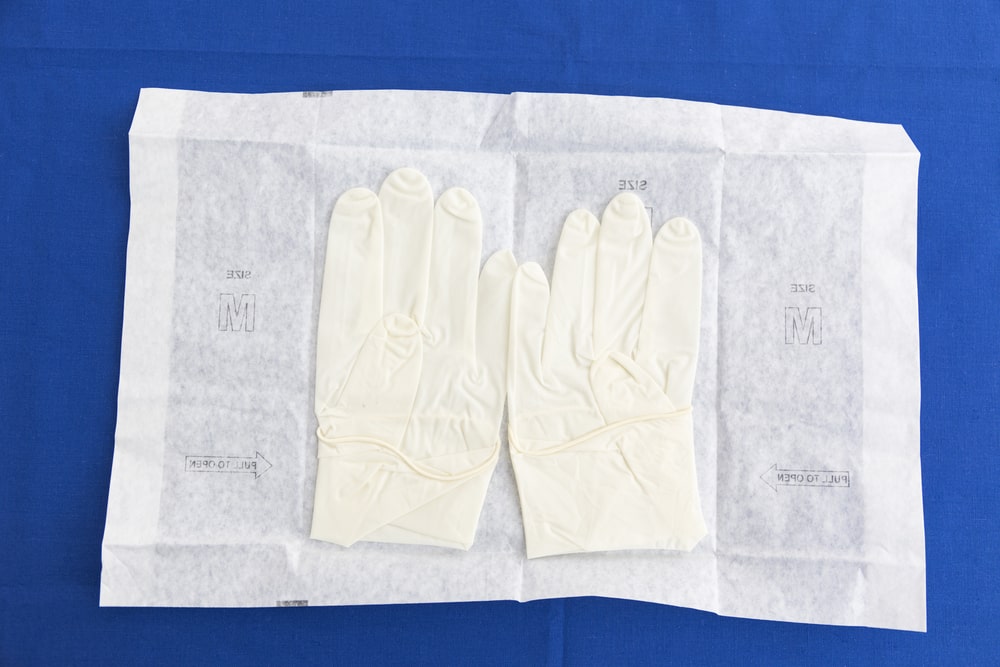Sterile vs Non Sterile Gloves: Know the Differences & When to Use?

Gloves are an important necessity we cannot do without in various industries like healthcare, food, and beverage, cleaning, and even movers and packers. However the role of gloves as well as the type of gloves to be used changes drastically according to its intent of use, purpose, and product nature.
For instance, one cannot use latex gloves while tampering with hot and cold products. Similarly, thermal wear gloves cannot be used in the healthcare industry. Gloves are generally made of a wide range of products like latex, vinyl, and nitrile or even sheepskin, wool, and silicon.
One of the most prominent sectors, where gloves are a mandated necessity, is the healthcare industry. From handling objectionable specimens and materials in the laboratory to managing surgeries, investigations and even examinations gloves are the most important barricade or protection against questionable foreign substances that may or may not cause harm to the body.
Two main types of gloves used in the healthcare industry include Sterile Gloves and Non Sterile gloves. Sterile vs non sterile gloves, which is the right choice, is one of the primary concerns for most newbies into the world of healthcare.
Sterile gloves are defined as the FDA specification approved gloves that are primarily used in any surgical procedures.
The gloves that are used for non-surgical purposes and intents and that do not require FDA approval for usage are called Non-sterile gloves.
What are sterile gloves?

Sterile gloves are exclusively FDA approved and only usable in Surgical procedures. The FDA norms use a certain standard protocol to categorize gloves under Sterile and Nonsterile types. Read more about sterile medical gloves on FDA website.
Deemed as perfect for use in Surgical procedures Sterile gloves undergo a massive number of rigorous sterilization and disinfection protocols to remove 99.99% of irritants, debris, and microorganisms. The result is a pair of gloves that can be safely used during Surgical protocols without fear of iatrogenic transfer of foreign particles to and from the operative case.
Sterile gloves are exclusively mandated for use within the surgical field only. ANy other variant of gloves is condemned unusable in surgical procedures by the FDA.
When would you use sterile gloves?
Sterile gloves are strictly used within the operative premises for the sole intent of surgical procedures. They are deemed 100% safe and microorganism free to be used during any surgical procedures.
Sterile gloves generally have a very high AQL standard along with strict and much more careful packaging and transportation standards.
Non Sterile gloves are used in the routine examination and diagnostic proceedings; They are deemed safe for use in non-surgical procedures because they too undergo sterilization process to remove any major harmful remnants or organisms. This is also the reason why Non-sterile gloves are also known as Non Surgical gloves.
Different types of sterile gloves:
- Sterile vinyl gloves – These gloves are made of PVC a petroleum-based compound. Comparatively cheaper and perfectly suited for surgical use, they are not very durable and are not very good for use against biomedical hazards and chemical exposure.
- Sterile nitrile gloves – Created out of synthetic rubber rather than natural latex, Sterile Nitrile gloves are very durable and resistant to punctures and abrasive forces. This makes them perfect to use as protection against chemical exposures, infections blood wounds, and other similar biohazardous situations.
- Sterile disposable gloves – Primarily used to prevent cross-contamination, Sterile Disposable Gloves are disposed of after a single usage. Vinyl is the most preferred choice for sterile disposable gloves as it is cheaper than Nitrile gloves.
- Sterile non-latex gloves – Latex is often known to cause skin irritation after prolonged use. Latex protein is very weak and easily prone to wear and tear. To battle, this issue alternate synthetic latex-like compounds are used in the creation of gloves. Some of these non-latex materials used include Polyvinyl chloride, Nitrile, Neoprene, etc. These materials are much more abrasive resistant and stronger than natural latex. Additionally, they are completely non-irritant on the skin during prolonged usage.
You may also like to know more about the difference between Nitrile, Vinyl & Latex gloves compositions, their properties and when to use them.
Where can I buy sterile gloves?
Sterile Gloves are available on various online shopping platforms. Additionally, they are also easily available for purchase at registered Medical depots and stores selling surgical goods.
What are the best sterile gloves?
There is a wide range of sterile gloves available in the market. From latex to PVC, neoprene, rubber, and Nitrile, one can choose to opt for Powdered or non powdered Sterile gloves.
Powdered gloves have cornstarch to help in lubrication while wearing the gloves. However, the powder can cause skin irritation or dryness which is why many prefer non-powdered variants of either of the types.
Are nitrile exam gloves sterile?
Nitrile gloves are available under both the sterile and non-sterile categories. Nitrile Examination gloves are not necessarily sterile as they are used for diagnostic and examination purposes only.
Another notable factor about Nitrile Gloves is that they are made of synthetic rubber that is extremely resistant to abrasion and puncture. This is the reason they can be used multiple times of up to 6 times under the Sterilization and High-Level Disinfection Protocol.
Do first aid gloves need to be sterile?
No, they are not sterile. The sole purpose of first aid gloves is to protect the examiner from the patient. Sterile gloves are only used during surgical wound repair where the probability of infectious exchange is very high.
Suggested article: Best Fingerless Gloves For Typing Smoothly on Computer
What do non sterile gloves mean?

Non sterile gloves have a SAl rating ranging between 1.5 to 2.5 as per FDA norms. Though they are not usable in operative and surgical scenarios, they are deemed perfectly safe to use for first aid, examination, and other investigative processes.
What are non-sterile gloves used for?
Non sterile gloves are generally disposable and solely have a single usage. They are used in a wide range of practices like
- First aid
- Aseptic procedures
- Handling biohazardous waste like feces, sputum, body fluid, etc.
- Examination of body cavities and wounds
- Handling laboratory equipment and specimens
- Surface contaminants and residues
Are non-sterile gloves safe for food?
Non sterile gloves are made of food grade safe compounds. The gloves are non reactive to food particles of any kind which deems them safe to use during food prep.
Also, non-sterile gloves undergo a specific set of sterilization techniques to remove any hazardous particles or organisms. Here are some of the best gloves for food preparation you can take a look at.
What are non-sterile latex gloves?
Non Sterile latex gloves are single-use disposable gloves used to protect against cross-contamination of patients and healthcare aid.
They are cheaper than PVC or Nitrile gloves and readily available.
What is the difference between sterile and nonsterile gloves?
In the battle of Sterile vs non sterile gloves, SAL is the primary determining factor for differentiating one from the other. SAL or Standard Assurance Level incorporates numerous mandated Sterilization techniques under it.
Sterile gloves have to undergo and pass all these sterilization techniques to be deemed approved for surgical use by the FDA. Post undergoing all the mandated sterilization techniques, the gloves are completely sterile and devoid of any and every microorganism that may have been present prior to the sterilization.
Non Sterile Gloves also undergo a repeated sterilization process to deem them safe for use, however, they are not 100% devoid of all microorganisms. This is the reason why non-sterile gloves are not used in Surgical procedures as Infection control is the major priority within the OT.
Additionally, Sterile gloves have an Acceptable Quality Level (AQL) ranging between 1 to 1.5 at max while in the case of non-sterile gloves it is 1.5 to 2.5.AQL is the assessment done based on the number of pinholes in the gloves. A score of 1 to 1.5 indicates that no more than 1.5% of the entire batch of gloves in a sample has pinholes in them.
One may ask what is the difference between sterile and nonsterile gloves if both are undergoing the same AQL testing.
Though AQL is a mandated test to differentiate between sterile and non-sterile gloves there is another aspect in relation to usability.
Sterile gloves have a specific field of use. Other than the fixed margins of the surgical field, these gloves are not used anywhere else. The main reason is the higher cost value of these gloves. Sterile gloves have very strict and regulated packaging and transportation mechanism, which automatically increases the production cost.
However, non-sterile gloves are comparatively cheaper due to a comparatively easier packaging and transportation regime. This is the reason why it can be used in other areas in addition to examination and investigations like Food and Beverage Industry.